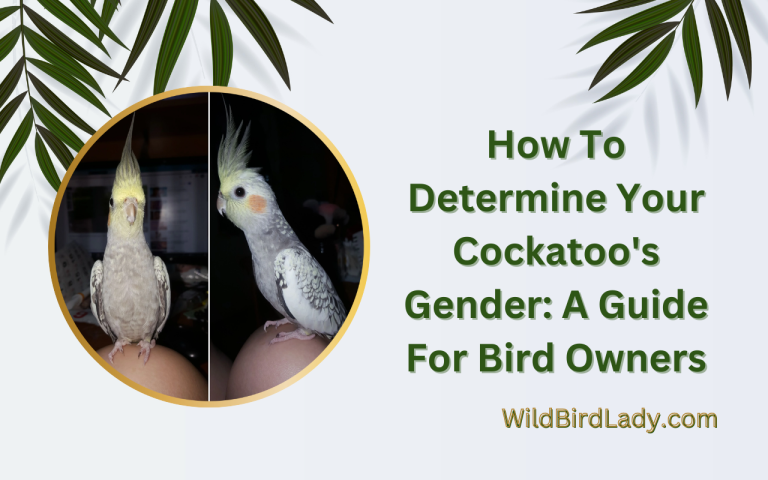How To Tell If Your Parrotlet Is A Boy Or A Girl
To determine the gender of your parrotlet, you need to look at their physical features. Males have blue feathers on their rump, while females have green.
Additionally, males may have a larger and more square-shaped head, while females may have a smaller and more rounded head. Parrotlets are adorable and tiny little birds that are well-known for their big personalities. One of the most common questions that a parrotlet owner has is how to determine the gender of their bird.
Knowing how to tell if your parrotlet is a boy or a girl is essential for their care, breeding, and even for giving them a proper name. In this article, we will be discussing how you can determine the gender of your parrotlet. Keep on reading to learn more.
Understanding The Basics Of Parrotlet Gender Identification
Whether you are a new pet owner or have had a parrotlet for some time, identifying the gender of your bird is crucial for its well-being. Male and female parrotlets have different qualities, and understanding their gender can help you provide a better living environment and anticipate any potential medical or behavioural issues.
Importance Of Knowing The Gender Of Your Parrotlet
Knowing the gender of your parrotlet can help you provide better care and reduce the risk of health problems. Here are some reasons why gender identification is essential:
- Behavioural differences: Male and female parrotlets tend to act differently. Understanding their behavioural patterns can help you train and socialize your bird correctly.
- Medical complications: The lack of knowledge about your parrotlet’s gender can lead to health problems such as egg-binding in females or testicular tumours in males.
- Bonding: Parrotlets bond differently with male and female owners, and knowing your bird’s gender can help you establish a stronger connection.
Physical Differences Between Male And Female Parrotlets
Identifying the gender of your parrotlet may appear overwhelming at first. However, some physical differences between male and female parrotlets are easy to spot. Here are some simple ways to distinguish between male and female parrotlets:
- Size: Males are typically larger than females, with a broader head and shoulders and a more substantial beak.
- Plumage: Female parrotlets have brighter plumage and a more prominent pattern around the eyes, while males usually have more subdued feathers.
- Behaviour: Males tend to show off when trying to attract a mate, rocking or bobbing their heads and spreading their wings, while females are more docile.
- Pelvic bones: The easiest way to determine the gender of your parrotlet is to look at the distance between the pelvic bones. Male parrotlets have a more significant gap between the bones, while female’s bones are closer together.
Identifying the gender of your parrotlet is essential for its well-being. By knowing the differences between males and females, you can provide a better living environment, avoid medical issues and establish a stronger bond with your feathered friend.
Feather Coloration As A Gender Indicator
When it comes to determining the gender of your pet parrotlet, one of the most reliable ways is to observe the bird’s feather coloration. Understanding the key differences in feather colors can help you determine whether your parrotlet is a boy or a girl.
In this section, we’ll discuss how genetics plays a role in feather coloration and what to look for when trying to identify your bird’s gender.
Differences In Feather Colors Between Male And Female Parrotlets
Male and female parrotlets have different feather coloration patterns that are determined by genetics. These differences are most prominent in certain areas of the bird’s body, such as the face, wings, and tail. Here are some key differences in feather coloration between male and female parrotlets:
- Male parrotlets often have brighter, more vibrant colors than females. For example, male pacific parrotlets have bright blue feathers on their wings and tail, whereas females have more muted green feathers in these areas.
- The feathers around a male parrotlet’s eyes are often brighter and more distinct than those of a female. In some species, such as the spectacled parrotlet, this area is a different color than the rest of the head.
- The markings on a male parrotlet’s wings and tail are often more pronounced and well-defined than those of a female. For example, male green rumped parrotlets have bright blue markings on their wings and tail that are absent in females.
Understanding The Role Of Genetics In Feather Coloration
The differences in feather coloration between male and female parrotlets are determined by genetics. Specifically, the genes that control the production of pigments in the feathers are sex-linked, meaning they are located on the x and y chromosomes. As a result, males and females inherit different combinations of these genes, which leads to differences in feather coloration.
For example, in pacific parrotlets, the gene that controls blue pigmentation is located on the sex-linked w chromosome. Males have two w chromosomes and one z chromosome, while females have only one w chromosome and two z chromosomes. This means that males have twice as many copies of the blue pigmentation gene as females, leading to more vibrant feather colors.
Determining the gender of your parrotlet can be challenging, but examining the bird’s feather coloration can be an effective method. Remember that there are other factors to consider as well, such as behavior and reproductive organs, and it’s always best to consult with an experienced veterinarian to ensure an accurate determination.
Behavioral Differences Between Male And Female Parrotlets
Are you curious about your parrotlet’s gender? Understanding whether you have a male or female parrotlet is essential as it can help you provide them with better care and attention. In this post, we’ll cover the behavioral differences between male and female parrotlets.
Let’s dive in!
Differences In Vocalization
Parrotlets are known for their high-pitched chirps and squawks. Did you know that the differences in vocalization can indicate the gender of your parrotlet? Here are some points to keep in mind:
- Male parrotlets tend to be more vocal than their female counterparts.
- Males are known to make repetitive chirping sounds to attract a mate.
- Female parrotlets are quieter and more reserved, only making occasional chirps to communicate with their owners.
Mating Behavior And Nesting Habits
Observing your parrotlet’s mating behavior and nesting habits can also provide insight into their gender. Here are some key differences to take note of:
- Male parrotlets tend to show off to attract a mate by fluffing their feathers and performing various displays.
- During mating season, males will attempt to mount and regurgitate food for their mate.
- Females will show more interest in nesting and building a home for their eggs.
- Female parrotlets will lay eggs even if they don’t have a mate, while males don’t lay eggs.
By understanding your parrotlet’s behaviors, you can determine their gender and provide them with better care. Remember to observe your parrotlet regularly and seek professional advice if you’re unsure.
Dna Sexing For Parrotlets
Parrotlets are small and adorable birds that make excellent pets. These birds are known to be popular because of their vibrant colors, energetic personalities, and playful attitude. Parrotlet owners are often curious about the sex of their pets and want to know whether their parrotlet is a boy or a girl.
One way to determine their pet’s gender is through dna sexing, which is the most accurate method. In this post, we will discuss the science behind dna sexing, the steps to take for dna sexing your parrotlet, the pros and cons of dna sexing, and how to find a reputable dna sexing laboratory.
The Science Behind Dna Sexing:
Dna sexing is a scientifically proven method that accurately determines the gender of a parrotlet by examining its dna. Male and female parrotlets have different sex chromosomes, with females having two x chromosomes, and males having one x and one y chromosome.
Dna sexing involves taking a blood sample from the bird, which is sent to a laboratory for analysis. The laboratory examines the dna in the blood sample to determine the bird’s gender.
Steps To Take For Dna Sexing Your Parrotlet:
- Find a reputable dna sexing laboratory: There are many laboratories that offer dna sexing services, so it is important to choose a reputable one.
- Contact the laboratory: Contact the laboratory to inquire about dna sexing, fees, and sample collection methods.
- Collect the dna sample: Dna samples can be taken from blood, feathers, or eggshells. The most common and easiest method is a blood sample, which requires a needle to prick a vein in the bird’s leg. This process is painless and quick.
- Send the sample to the laboratory: The blood sample should be packaged carefully and sent to the laboratory for analysis.
- Wait for the results: The laboratory usually provides results within a few days.
Pros And Cons Of Dna Sexing:
Pros:
- Dna sexing is the most accurate method to determine a parrotlet’s gender.
- Identifying the bird’s gender correctly can help owners provide the best care and ensure they do not accidentally breed their pets.
- Dna sexing can be done at any age.
- Dna sexing can be done on any type of parrotlet.
Cons:
- Dna sexing can be expensive.
- Collecting the dna sample can be stressful for the bird.
Looking For A Reputable Dna Sexing Laboratory:
When looking for a reputable dna sexing laboratory, consider the following:
- Choose a laboratory that specializes in avian dna sexing.
- Look for a laboratory with a good reputation and positive reviews.
- Check the laboratory’s accreditation and certifications.
- Research the laboratory’s experience and whether it is trusted by veterinarians and pet owners.
Dna sexing is a reliable and accurate method for determining a parrotlet’s gender. Knowing your pet’s gender is essential in providing the best care possible and avoiding unintentional breeding. When looking for a reputable laboratory, it is important to do thorough research to ensure the accuracy and reliability of the results.
Creating An Optimal Environment For Your Parrotlet
Housing Considerations
Parrotlets are small birds, but they are intelligent and active flyers. As such, they need an adequate space to move around. It is important to provide them with a suitable cage that is not only spacious but also secure. Here are some factors to consider when choosing a cage:
- Choose a cage that is at least 18 inches wide, 18 inches deep, and 24 inches tall.
- The bar spacing should be 1/2 inch apart.
- The cage should have horizontal bars where parrotlets can climb.
- Avoid round cages as parrotlets need corners to feel safe.
- Place the cage in a quiet and well-lit room away from drafts, smoke, and fumes.
Temperature And Lighting Requirements
Parrotlets are sensitive to temperature changes. They originate from warm climates, so it is crucial to keep their environment at the right temperature. Here are some tips:
- Keep the temperature between 65-80°f (18-27°c).
- Avoid placing their cage near windows, doors or air conditioning vents.
- Provide 10-12 hours of natural or artificial light every day.
Optimal Diet For Parrotlets
Feeding your parrotlet a healthy and balanced diet is crucial for their wellbeing. Here are some foods to include in their diet:
- Pellets are the staple food for parrotlets as they provide all the necessary nutrients.
- Fresh fruits and vegetables provide vitamins and minerals.
- Small amounts of seeds and nuts can serve as a treat.
- Avoid feeding them avocado, chocolate, caffeine, alcohol, and sugary or salty foods.
Creating an optimal environment for your parrotlet involves providing the right housing, temperature, lighting, and diet. By taking these factors into consideration, you can ensure that your parrotlet lives a happy and healthy life.
Parrotlet Health Maintenance
Maintaining the health of your parrotlet is crucial in ensuring its longevity and continued happiness. As a responsible bird owner, it’s essential to understand the signs of a healthy parrotlet, common health issues, and how to prevent them, and finding a reliable avian veterinarian in case of emergencies.
Signs Of A Healthy Parrotlet
Here are some indications that your parrotlet is in good health:
- Active and engaged in its surroundings
- Regular eating habits
- Clean bill of health from the veterinarian
- Clean feathers and skin
- Responsive to sounds and touch
Common Health Issues And How To Prevent Them
While parrotlets are generally sturdy and resilient birds, they are not immune to medical issues. Here are some common health issues and how to prevent them:
- Feather plucking: Parrotlets may start plucking their feathers when they are bored, stressed, or have an underlying medical condition. To prevent feather plucking, provide your parrotlet with plenty of toys, social interaction, and a balanced diet.
- Psittacosis: A bacterial infection that can affect all parrot species, including parrotlets. To prevent psittacosis, maintain hygienic conditions in the bird’s living space, including cleaning the food bowls and changing the water daily. Wash your hands thoroughly before and after handling your bird, and keep it away from other birds that may carry the infection.
- Obesity: Parrotlets may become overweight if they consume a diet high in fat and low in nutrients. To prevent obesity, provide a varied diet that includes fruits, vegetables, and high-quality pellets in moderation. Encourage physical activity by providing toys that promote movement and playtime outside its cage.
- Fatty liver disease: An underlying condition in overweight parrotlets that can cause liver damage. To prevent fatty liver disease, follow a balanced diet plan and provide plenty of opportunities for exercise and playtime.
- Respiratory infections: Parrotlets are susceptible to respiratory infections, which can be caused by various factors, such as bacterial infections, mold, and dust. To prevent respiratory issues, keep your bird’s living space clean and hygienic, ensuring adequate ventilation and avoiding smoke and other pollutants.
Finding A Reliable Veterinarian Who Specializes In Avian Care
Finding a knowledgeable and trustworthy veterinarian who specializes in avian care is essential to ensure your parrotlet receives the best possible care. When looking for a vet, consider the following:
- Ask other bird owners for recommendations
- Research the veterinarian’s credentials and experience with avian care
- Schedule a consultation and ask questions to gauge their expertise and commitment to your bird’s health
- Consider the proximity of the veterinary practice for emergencies
By following the tips outlined above, you can ensure that your parrotlet stays healthy and happy for years to come. Remember, prevention is key, and regular check-ups with a veterinarian can help detect and address any health issues early.
Frequently Asked Questions On How To Tell If Your Parrotlet Is A Boy Or A Girl
How Can You Tell If A Parrotlet Is A Male Or Female?
Male parrotlets have a blue coloration, while females have a green coloration on their rump. Males have a blue or purple band above their beaks, also known as a “mask,” while females do not.
At What Age Can You Determine If A Parrotlet Is Male Or Female?
Parrotlets can be sexed visually once they reach about 6 months of age. At this point, their feather coloration and other physical characteristics become more distinguishable.
Can You Determine The Sex Of A Parrotlet Through Their Behavior Or Personality?
No, parrotlet behavior and personality do not differ between males and females. The only way to accurately determine the sex of a parrotlet is through their physical characteristics, such as coloration and body structure.
Can You Determine The Sex Of A Parrotlet Through Dna Testing?
Yes, dna testing is a highly accurate method of determining the sex of a parrotlet. It involves taking a small blood or feather sample and sending it to a lab, which will analyze the genetic material to determine the bird’s sex.
Is It Important To Know The Sex Of A Parrotlet?
Knowing the sex of your parrotlet can be helpful for breeding, as pairing two birds of the same sex will not produce offspring. Additionally, male and female parrotlets may have slightly different care requirements, so knowing their sex can help ensure optimal care.
Conclusion
Determining the gender of your parrotlet is crucial if you want to breed them or if you simply want to provide them with the appropriate care they need. To identify the sex of your parrotlet, you can look for physical differences such as their coloration, size, and characteristics.
With proper observation and due diligences, you can find out if your feathered friend is a boy or a girl. Keep in mind that some color mutations can make identifying the sex tricky, and in such cases, it’s always best to seek the opinion of a veterinarian.
At the end of the day, no matter what gender your parrotlet is, ensure that they receive the attention, care, and love they deserve as they are extraordinary pets that can bring joy, entertainment, and immense companionship to your life.
So, go ahead and cherish every moment you have with your little buddy!








